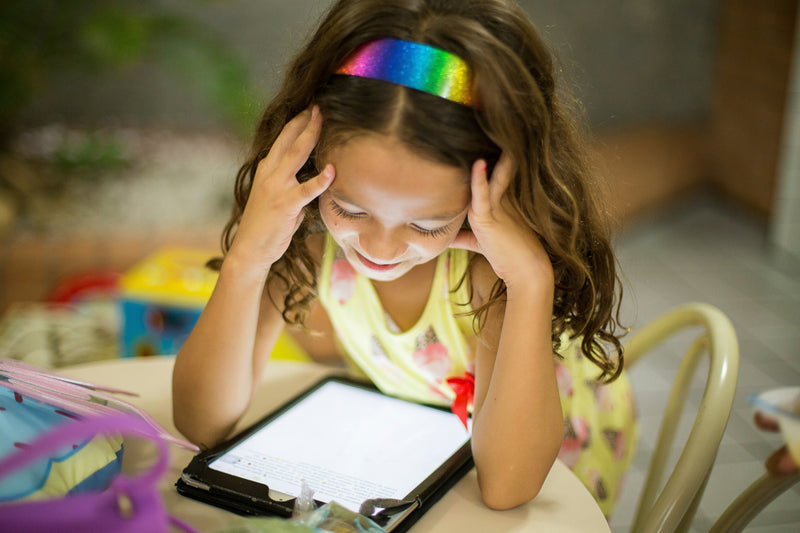
Digital Citizens: Teaching Children Responsible Device Use in Our Connected World 📱🌍
Picture this: Your seven-year-old is curled up on the couch, tablet in hand, completely absorbed in an educational app about the solar system. They're learning, they're engaged, and for a blissful moment, technology feels like the amazing tool it can be. But then dinner time arrives, and what follows is a meltdown of epic proportions when it's time to put the device away. Sound familiar? This scenario plays out in homes everywhere as families navigate the complex landscape of raising digitally responsible children in an increasingly connected world. 📚🚀
The Digital Reality: Why Device Responsibility Matters More Than Ever 🎯💡
Let's start with some context that might surprise you. Today's children are growing up as true digital natives—they've never known a world without smartphones, tablets, and instant connectivity. While this brings incredible opportunities for learning and creativity, it also presents unique challenges that previous generations never faced.
Research reveals some compelling truths about children and technology:
- Children who learn healthy tech habits early show better self-regulation skills overall 🧠✨
- Balanced screen time is linked to improved sleep quality and physical health 😴🏃♀️
- Kids who understand digital citizenship become more empathetic online communicators 💬❤️
- Children with device boundaries demonstrate stronger focus and attention spans 🎯🔍
- Early tech responsibility correlates with better decision-making in adolescence 🤔👍
The Confident Mindset Journal helps kids take a break from their devices. 📔💭
Understanding the Digital Difference: Why Kids Need Different Rules 👶🔧
Before diving into strategies, it's crucial to understand why children's brains interact with technology differently than adult brains:
The Dopamine Factor 🧬
Children's reward systems are still developing, making them more susceptible to the instant gratification that devices provide. Those notification pings and game rewards trigger powerful chemical responses that can be genuinely addictive.
Attention Development 🎪
Young brains are still learning how to filter information and maintain focus. The constant stimulation from devices can interfere with these crucial developmental processes.
Social Learning 👫
Children learn social cues, empathy, and communication through face-to-face interaction. Too much screen time can impact these essential social skills.
Sleep and Physical Health 💤
Blue light exposure and device stimulation can significantly impact children's sleep patterns and physical development in ways that affect adults less severely.
The stories in the My Furry Soulmates series are a great alternative to so much screen time! 📚🐾
What Responsible Device Use Actually Looks Like 👀✅
Let's get specific about what healthy technology habits look like during childhood, because it's not about eliminating devices—it's about intentional use:
Signs of responsible device use:
- Can transition away from devices without major meltdowns 🔄😌
- Uses technology for creation, not just consumption 🎨📝
- Asks permission before downloading apps or visiting new websites 🙋♀️🔒
- Shows awareness of time spent on devices ⏰🤔
- Demonstrates empathy and kindness in digital interactions 💝💬
- Balances screen time with physical play and real-world activities ⚖️🏃♂️
Warning signs of problematic device use:
- Extreme emotional reactions when devices are taken away 😡💥
- Lying about screen time or sneaking device use 🤐📱
- Physical symptoms like headaches or eye strain 🤕👀
- Declining interest in offline activities and relationships 📉👫
- Sleep disruption or changes in eating patterns 😴🍽️
- Difficulty focusing on non-screen activities 📚😵💫
The Curiosity Mindset Journal encourages children to explore questions about their technology use and discover what makes them feel most balanced and engaged. 🔍🌈
The Foundation: Building Digital Citizenship from the Start 🏗️🏛️
Responsible device use isn't just about screen time limits—it's about raising children who understand how to be good digital citizens. This involves several key components:
Understanding Digital Footprints 👣
Even young children can grasp the concept that what they do online leaves traces. Simple explanations like "the internet remembers everything" help children think before they act online.
Developing Empathy Online 💛
Teaching children that there are real people behind screens helps them maintain kindness and respect in digital interactions.
Learning Privacy Basics 🔐
Age-appropriate lessons about not sharing personal information online set the foundation for future digital safety.
Recognizing Trustworthy Sources 🔍
Even elementary-aged children can begin learning to question whether information online is reliable or true.
Understanding Time and Balance ⚖️
Helping children recognize how technology makes them feel and when they've had "enough" builds internal awareness and self-regulation.
The Kindness Mindset Journal helps children apply their natural empathy to digital interactions, creating more thoughtful online citizens. 📔💕
Practical Strategies: Creating Healthy Device Habits 🛠️📋
Ready to help your children develop responsible device use? These evidence-based strategies make a real difference:
Establish Clear, Consistent Boundaries 🚧
Create specific rules about when, where, and how devices can be used. Consistency helps children develop internal structure around technology.
Model Healthy Tech Habits 👨👩👧👦
Children learn more from what they see than what they hear. Demonstrate the device habits you want them to develop.
Create Tech-Free Zones and Times 🚫📱
Designate spaces (like bedrooms) and times (like meals) where devices aren't allowed, preserving important aspects of childhood development.
Use Timers and Visual Cues ⏲️👀
Help children understand time limits by using visual timers and giving warnings before transition times.
Prioritize Creation Over Consumption 🎨📚
Encourage children to use technology for making things—videos, stories, art—rather than just consuming content.
Co-View and Co-Play 👫🎮
Engage with your children's digital activities. Play their games, watch their shows, and discuss what they're experiencing.
Teach the "Pause and Think" Strategy 🛑🤔
Before clicking, sharing, or responding online, children can learn to pause and consider: "Is this kind? Is this true? Is this necessary?"
Regular Digital Detox Periods 🌿🔄
Schedule regular breaks from all screens to help children reconnect with offline activities and relationships.
The Confident Mindset Journal provides structured reflection prompts that help children develop awareness of their technology choices and their impacts. 📝✨
Age-Appropriate Guidelines: Tailoring Approach by Development Stage 📏👶
Different ages require different approaches to device responsibility:
Ages 3-5: Foundation Building 🏗️
- Very limited screen time with high-quality, educational content
- Always co-viewing with adults
- Focus on learning basic concepts like "screen time" and "real world time"
- Simple rules: "Devices stay in the living room"
Ages 6-8: Skill Development 🌱
- Introduce basic digital citizenship concepts
- Begin teaching about kindness online
- Practice transitions with timers and warnings
- Start discussions about how technology makes them feel
Ages 9-11: Expanding Responsibility 🚀
- More independent device use with clear boundaries
- Learning about digital footprints and privacy basics
- Beginning to evaluate content quality and truthfulness
- Taking ownership of their device use choices
Ages 12+: Preparing for Independence 🦅
- Collaborative creation of family media agreements
- Deeper discussions about digital citizenship and online safety
- Gradual increase in responsibility and independence
- Focus on internal motivation rather than external controls
Common Device Dilemmas: Navigating Tricky Situations 🤔⚠️
Every family faces these challenging scenarios. Here's how to handle them:
The Meltdown at Screen Time End 😭📱
Instead of removing devices abruptly, use timers, warnings, and transition activities. Acknowledge feelings while maintaining boundaries.
Inappropriate Content Discovery 😱💻
Stay calm, remove the device, and use it as a learning opportunity about internet safety and family values.
The "But Everyone Else Has It" Argument 🙄👥
Acknowledge their feelings while explaining that different families have different rules based on their values and children's individual needs.
Sneaky Device Use 🕵️♂️📲
Address the behavior directly, understand the underlying need, and work together to find solutions that meet everyone's needs.
Device Addiction Concerns 😰🔄
Look for professional guidance if device use significantly interferes with sleep, school, relationships, or physical health.
The Technology Opportunity: Using Devices for Character Building 💪🌟
When used thoughtfully, technology can actually support character development:
- Problem-solving skills: Coding and puzzle games develop logical thinking 🧩💻
- Creativity: Digital art, music, and storytelling tools expand creative expression 🎨🎵
- Global awareness: Age-appropriate content can expand children's understanding of the world 🌍📖
- Communication skills: Video calls with family and supervised online interactions build social connections 📞👫
- Learning acceleration: High-quality educational apps can supplement traditional learning 📚🚀
Creating Your Family Media Agreement 📋🏠
One of the most powerful tools for responsible device use is a collaborative family media agreement. This isn't a list of rules imposed by parents, but a jointly created document that includes:
- Agreed-upon screen time limits and schedules ⏰📅
- Guidelines for appropriate content 👍📺
- Consequences for breaking agreements 📝⚖️
- Regular review and adjustment dates 🔄📆
- Everyone's signatures, including children 🖋️👨👩👧👦
This process helps children feel ownership over their technology choices while maintaining necessary structure and safety.
The Long Game: Digital Citizenship for Life 🌍🔮
When we invest in teaching responsible device use during childhood, we're preparing children for a lifetime of healthy technology relationships:
- Academic success: Students who manage technology well show better focus and learning outcomes 📚🎓
- Professional readiness: Tomorrow's workforce requires both digital literacy and digital wisdom 💼🧠
- Mental health protection: Healthy tech habits reduce risks of anxiety, depression, and addiction 🧘♀️❤️
- Relationship quality: Balanced technology use preserves and enhances real-world connections 👫💝
- Innovation potential: Children who see technology as a tool (not entertainment) become creators and innovators 💡🚀
By using tools like the Confident Mindset Journal, Curiosity Mindset Journal, Kindness Mindset Journal, and the stories in the My Furry Soulmates series, we provide children with the reflection tools and character models they need to navigate our digital world thoughtfully. 📚🧱
Starting Today: Simple Steps for Digital Responsibility 👣🌱
Building responsible device use doesn't require a complete technology overhaul. Start with these manageable approaches:
- Have one screen-free meal together daily 🍽️👨👩👧👦
- Create a "device parking" station for the family 🚗📱
- Institute a "devices sleep outside bedrooms" rule 😴🚫
- Schedule weekly "digital detox" hours 🌿⏰
- Ask children how technology makes them feel 🤔💭
- Model the device behavior you want to see 👀🔄
- Use the Confident Mindset Journal to reflect on technology choices and their impacts 📝
Join Our Digital Citizenship Conversation! 💬❤️
How have you helped the children in your life develop responsible device habits? What strategies have worked best for your family? Share your experiences in the comments below!
Remember: Teaching responsible device use isn't about rejecting technology—it's about helping children harness its incredible power while maintaining their human connections, creativity, and well-being. When we guide children to become thoughtful digital citizens during their formative years, we're not just protecting their childhood—we're preparing them to be the kind of humans our connected world desperately needs: people who use technology intentionally, kindly, and wisely. ✨🌟



0 comments